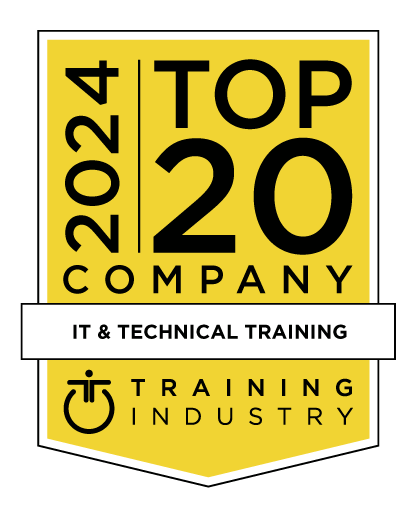title
Please take a moment to fill out this form. We will get back to you as soon as possible.
All fields marked with an asterisk (*) are mandatory.
Configuring Windows Server Hybrid Advanced Services
Course Description
Overview
This course teaches IT Professionals to configure advanced Windows Server services using on-premises, hybrid, and cloud technologies. The course teaches IT Professionals how to leverage the hybrid capabilities of Azure, how to migrate virtual and physical server workloads to Azure IaaS, and how to secure Azure VMs running Windows Server. The course also teaches IT Professionals how to perform tasks related to high availability, troubleshooting, and disaster recovery. The course highlights administrative tools and technologies including Windows Admin Center, PowerShell, Azure Arc, Azure Automation Update Management, Microsoft Defender for Identity, Azure Security Center, Azure Migrate, and Azure Monitor.Objectives
Audience
Prerequisites
-
Before attending this course, students must have:
- Experience with managing Windows Server operating system and Windows Server workloads in on-premises scenarios, including AD DS, DNS, DFS, Hyper-V, and File and Storage Services
- Experience with common Windows Server management tools (implied in the first prerequisite).
- Basic knowledge of core Microsoft compute, storage, networking, and virtualization technologies (implied in the first prerequisite).
- Experience and an understanding of core networking technologies such as IP addressing, name resolution, and Dynamic Host Configuration Protocol (DHCP)
- Experience working with and an understanding of Microsoft Hyper-V and basic server virtualization concepts
- An awareness of basic security best practices
- Basic understanding of security-related technologies (firewalls, encryption, multi-factor authentication, SIEM/SOAR).
- Basic knowledge of on-premises resiliency Windows Server-based compute and storage technologies (Failover Clustering, Storage Spaces).
- Basic experience with implementing and managing IaaS services in Microsoft Azure
- Basic knowledge of Azure Active Directory
- Experience working hands-on with Windows client operating systems such as Windows 10 or Windows 11
- Basic experience with Windows PowerShell
- High availability and disaster recovery
- Automation
- Monitoring
- Troubleshooting
Topics
- Introduction
- Implement network security groups and Windows IaaS VMs
- Implement adaptive network hardening
- Implement Azure Firewall and Windows IaaS VMs
- Implement Windows firewall with Windows Server IaaS VMs
- Choose the appropriate filtering solution
- Deploy and configure Azure firewall using the Azure portal
- Capture network traffic with network watcher
- Log network traffic to and from a VM using the Azure portal
- Knowledge check
- Introduction
- Describe Azure Security Center
- Enable Azure Security Center in hybrid environments
- Implement and assess security policies
- Protect your resources with Azure Security Center
- Implement Azure Sentinel
- Knowledge check
- Introduction
- Describe update management
- Enable update management
- Deploy updates
- View update assessments
- Manage updates for your Azure Virtual Machines
- Knowledge check
- Introduction
- Describe adaptive application control
- Implement adaptive application control policies
- Knowledge check
- Introduction
- Describe Azure Disk Encryption and server-side encryption
- Configure Key Vault for Azure Disk Encryption
- Encrypt Azure IaaS Virtual Machine hard disks
- Back up and recover data from encrypted disks
- Create and encrypt a Windows Virtual Machine
- Knowledge check
- Introduction
- Implement Change Tracking and Inventory
- Manage Change Tracking and Inventory
- Manage tracked files
- Implement File Integrity Monitoring
- Select and monitor entities
- Use File Integrity Monitoring
- Knowledge check
- Introduction
- Implement split-horizon DNS
- Create DNS policies
- Implement DNS policies
- Secure Windows Server DNS
- Implement DNSSEC
- Knowledge check
- Introduction
- Configure user account rights
- Protect user accounts with the Protected Users group
- Describe Windows Defender Credential Guard
- Block NTLM authentication
- Locate problematic accounts
- Knowledge check
- Introduction
- Describe Local Password Administrator Solution
- Configure Privileged Access Workstations
- Secure domain controllers
- Analyze security configuration with Security Compliance Toolkit
- Secure SMB traffic
- Knowledge check
- Introduction
- Explore Windows Update
- Outline Windows Server Update Services server deployment options
- Define Windows Server Update Services update management process
- Describe the process of Update Management
- Knowledge check
- Introduction
- Determine the functionality of Cluster Shared Volumes
- Explore the architecture and components of Cluster Shared Volumes
- Implement Cluster Shared Volumes
- Knowledge check
- Introduction
- Define Windows Server failover clustering
- Plan Windows Server failover clustering
- Implement Windows Server failover clustering
- Manage Windows Server failover clustering
- Implement stretch clusters
- Define cluster sets
- Knowledge check
- Introduction
- Select high-availability options for Hyper-V
- Consider network load balancing for Hyper-V VMs
- Implement Hyper-V VM live migration
- Implement Hyper-V VMs storage migration
- Knowledge check
- Introduction
- Explore the Windows Server File Server high-availability options
- Define Cluster Shared Volumes
- Implement Scale-Out File Server
- Implement Storage Replica
- Knowledge check
- Introduction
- Describe virtual machine scale sets
- Implement scaling
- Implement load-balancing VMs
- Create a virtual machine scale set in the Azure portal
- Describe Azure Site Recovery
- Implement Azure Site Recovery
- Knowledge check
- Introduction
- Define Hyper-V Replica
- Plan for Hyper-V Replica
- Configure and implement Hyper-V Replica
- Define extended replication
- Define Azure Site Recovery
- Implement Site Recovery from on-premises site to Azure
- Implement Site Recovery from on-premises site to on-premises site
- Knowledge check
- Introduction
- Describe Azure Backup
- Implement recovery vaults
- Implement Azure Backup policies
- Recover Windows IaaS Virtual Machines
- Perform file and folder recovery
- Perform backup and restore of on-premises workloads
- Manage Azure Virtual Machine backups with Azure Backup service
- Knowledge check
- Introduction
- Azure Site Recovery overview
- Workloads supported for protection with Azure Site Recovery
- Run a disaster recovery drill
- Failover and failback
- Introduction
- What is Azure Site Recovery
- Prepare for disaster recovery with Azure Site Recovery
- Exercise - Set up disaster recovery with Azure Site Recovery
- Run a disaster recovery drill
- Exercise - Run a disaster recovery drill
- Failover and failback using Azure Site Recovery
- Exercise - Failover and failback using Azure Site Recovery
- Introduction
- Azure Backup features and scenarios
- Back up an Azure virtual machine by using Azure Backup
- Exercise - Back up an Azure virtual machine
- Restore virtual machine data
- Exercise - Restore Azure virtual machine data
- Introduction
- Plan your migration
- Describe Azure Migrate
- Perform server assessment
- Assess physical servers with Azure Migrate
- Migrate Windows Server workloads by using Azure Migrate
- Knowledge check
- Introduction
- Describe Azure Migrate
- Migrate Windows Server workloads by using Azure Migrate
- Describe storage migration
- Migrate file servers by using Storage Migration Service
- Knowledge check
- Introduction
- Examine upgrade vs. migration
- Upgrade a previous version of Active Directory Domain Services to Windows Server 2022
- Migrate to Active Directory Domain Services in Windows Server 2022 from a previous version
- Explore the Active Directory Migration Tool
- Knowledge check
- Introduction
- Storage Migration Service overview and usage scenarios
- Storage migration requirements
- Migrate a server with Storage migration
- Evaluate storage migration considerations
- Knowledge check
- Introduction
- Describe the Windows Server Migration Tools
- Install the Migration Tools
- Migrate roles using the Migration Tools
- Knowledge check
- Introduction
- Azure Migrate App Containerization overview
- Exercise - Set up host environment
- Exercise - Discover your ASP.NET web application
- Exercise - Build container image for your ASP.NET app
- Exercise - Deploy app container to App Service
- Introduction
- Enable Azure Monitor for Virtual Machines
- Monitor an Azure Virtual Machine with Azure Monitor
- Enable Azure Monitor in hybrid scenarios
- Collect data from a Windows computer in a hybrid environment
- Integrate Azure Monitor with Microsoft Operations Manager
- Knowledge check
- Introduction
- Monitoring for Azure VMs
- Monitor VM host data
- Use Metrics Explorer to view detailed host metrics
- Collect client performance counters by using VM insights
- Collect VM client event logs
- Introduction
- Use Performance Monitor to identify performance problems
- Use Resource Monitor to review current resource usage
- Review reliability with Reliability Monitor
- Implement a performance monitoring methodology
- Use Data Collector Sets to analyze server performance
- Monitor network infrastructure services
- Monitor virtual machines running Windows Server
- Monitor performance with Windows Admin Center
- Use System Insights to help predict future capacity issues
- Optimize the performance of Windows Server
- Knowledge check
- Introduction
- Describe Windows Server event logs
- Use Windows Admin Center to review logs
- Use Server Manager to review logs
- Use custom views
- Implement event log subscriptions
- Knowledge check
- Introduction
- Describe basic auditing categories
- Describe advanced categories
- Log user access
- Enable setup and boot event collection
- Knowledge check
- Introduction
- Diagnose DHCP problems
- Diagnose DNS problems
- Diagnose IP configuration issues
- Diagnose routing problems
- Use Packet Monitor to help diagnose network problems
- Use Azure Network Watcher to help diagnose network problems
- Knowledge check
- Introduction
- Troubleshoot VM deployment
- Troubleshoot VM startup
- Troubleshoot VM extensions
- Troubleshoot VM connectivity
- Troubleshoot VM performance
- Troubleshoot VM storage
- Knowledge check
- Introduction
- Recover objects from the AD recycle bin
- Recover the AD DS database
- Recover SYSVOL
- Troubleshoot AD DS replication
- Troubleshoot hybrid authentication issues
- Knowledge check
Related Courses
-
Microsoft Azure Security Technologies
MOC-AZ-500T00- Duration: 4 Days
- Delivery Format: Classroom Training, Online Training
- Price: 2,380.00 USD
-
Introduction to Microsoft Azure
MOC-AZ-900T00- Duration: 1 Day
- Delivery Format: Classroom Training, Online Training
- Price: 595.00 USD
Self-Paced Training Info
Learn at your own pace with anytime, anywhere training
- Same in-demand topics as instructor-led public and private classes.
- Standalone learning or supplemental reinforcement.
- e-Learning content varies by course and technology.
- View the Self-Paced version of this outline and what is included in the SPVC course.
- Learn more about e-Learning
Course Added To Shopping Cart
bla
bla
bla
bla
bla
bla
Self-Paced Training Terms & Conditions
Exam Terms & Conditions
ONCE YOU PURCHASE THIS EXAM YOU WILL NOT BE ABLE TO CANCEL YOUR ORDER. You are billed for the course after hitting submit. Exams are non-refundable.
Vouchers expire 12 months from the date they are issued, unless otherwise specified in the terms and conditions. Voucher expiration dates cannot be extended. All sales are final.Please refer to the full terms and conditions here.
Sorry, there are no classes that meet your criteria.
Please contact us to schedule a class.

STOP! Before You Leave
Save 0% on this course!
Take advantage of our online-only offer & save 0% on any course !
Promo Code skip0 will be applied to your registration
Purchase Information
title
Please take a moment to fill out this form. We will get back to you as soon as possible.
All fields marked with an asterisk (*) are mandatory.










